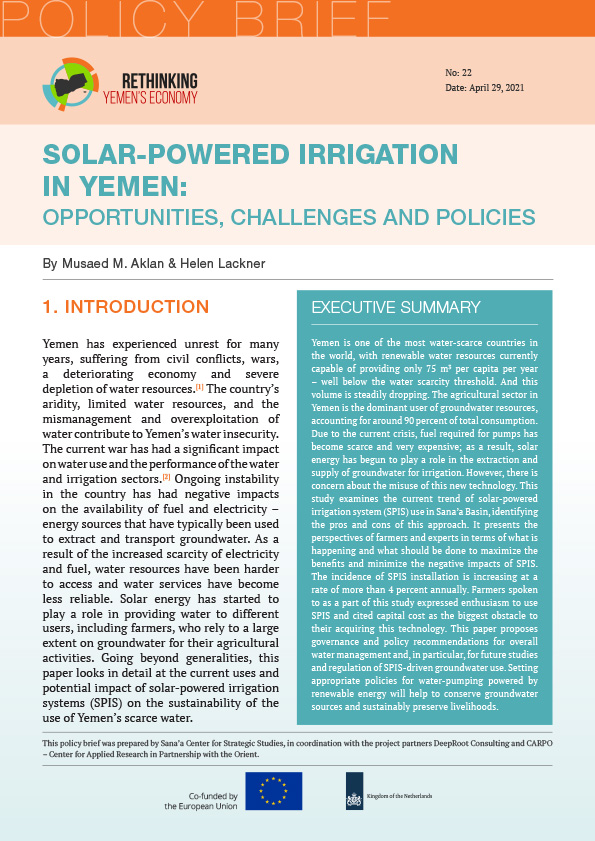Executive Summary
Yemen is one of the most water-scarce countries in the world, with renewable water resources currently capable of providing only 75 m3 per capita per year – well below the water scarcity threshold. And this volume is steadily dropping. The agricultural sector in Yemen is the dominant user of groundwater resources, accounting for around 90 percent of total consumption. Due to the current crisis, fuel required for pumps has become scarce and very expensive; as a result, solar energy has begun to play a role in the extraction and supply of groundwater for irrigation. However, there is concern about the misuse of this new technology. This study examines the current trend of solar-powered irrigation system (SPIS) use in Sana’a Basin, identifying the pros and cons of this approach. It presents the perspectives of farmers and experts in terms of what is happening and what should be done to maximize the benefits and minimize the negative impacts of SPIS. The incidence of SPIS installation is increasing at a rate of more than 4 percent annually. Farmers spoken to as a part of this study expressed enthusiasm to use SPIS and cited capital cost as the biggest obstacle to their acquiring this technology. This paper proposes governance and policy recommendations for overall water management and, in particular, for future studies and regulation of SPIS-driven groundwater use. Setting appropriate policies for water-pumping powered by renewable energy will help to conserve groundwater sources and sustainably preserve livelihoods.
1. Introduction
Yemen has experienced unrest for many years, suffering from civil conflicts, wars, a deteriorating economy and severe depletion of water resources.[1] The country’s aridity, limited water resources, and the mismanagement and overexploitation of water contribute to Yemen’s water insecurity. The current war has had a significant impact on water use and the performance of the water and irrigation sectors.[2] Ongoing instability in the country has had negative impacts on the availability of fuel and electricity – energy sources that have typically been used to extract and transport groundwater. As a result of the increased scarcity of electricity and fuel, water resources have been harder to access and water services have become less reliable. Solar energy has started to play a role in providing water to different users, including farmers, who rely to a large extent on groundwater for their agricultural activities. Going beyond generalities, this paper looks in detail at the current uses and potential impact of solar-powered irrigation systems (SPIS) on the sustainability of the use of Yemen’s scarce water.
This study focuses on Sana’a Basin, where the shortage of water is among the most problematic. Of all global national capitals, Sana’a has often been identified as the one most likely to run out of water first.[3] It is important to remember that the hydrology of Yemen varies considerably and therefore findings about Sana’a cannot be assumed to be valid for other basins and regions. However, there are some principles and recommendations of a general nature that are valid across the country. Strategies and detailed policies must, of course, be specific to each basin and region.
None of the official authorities and their related policies/strategies, including the Ministry of Electricity and Energy (MEE), the Ministry of Water and Environment (MWE) and the Ministry of Agriculture, Irrigation and Fisheries (MAIF), have addressed the issues associated with the use of solar energy in Yemen.[4] There are a few studies about solar energy for domestic use,[5] but these have little bearing on the technology’s use for agricultural water extraction. A 2019 UNDP report, the only study so far to discuss the use of SPIS in Yemen, determined the positive advantages of SPIS and promoted its use, but said little about the possible impact of SPIS on groundwater sources.[6]
One of the main issues in water management in Yemen is the considerable groundwater over-extraction, which threatens the viability of life in many parts of the country, as water availability diminishes. One of the problems faced by planners is the complete absence of policies and regulations for the management of new solar energy technologies used for water extraction, but they must also contend with the absence of detailed analysis based on actual field data for SPIS. This paper contributes to reducing this gap. If the over-extraction issue remains unaddressed, the further deterioration of water availability will make life in parts of the country more challenging, if not impossible. With the growing demand for SPIS in Yemen – and given its ability to provide affordable, clean-energy solutions – this paper aims to propose recommendations for governance and donor/financer approaches to the recognition and regulation of SPIS-driven groundwater use.
2. Background
2.1 Water situation in Yemen
There are 29 million Yemenis, 70 percent of whom live in rural areas and more than 50 percent of whom depend on agriculture. Yemen has no lakes or permanent rivers: rainfall and groundwater are the main sources of water in the country. Agriculture is estimated to use 90 percent of groundwater resources in Yemen, even though it only generates less than 20 percent of GDP.[7]
Yemen suffers from extreme water scarcity. Per capita water availability has dropped steadily in past decades as known available resources have remained static or have diminished while the population has increased. The annual volume of renewable water per capita declined from 221 m3 in 1992 to 80 m3 in 2014 and to only 75 m3 in 2017;[8] the latter is just over one percent of the global per capita average (5,925 m3) and 14 percent of the Middle East and North Africa region per capita average (554 m3). Yemen’s trajectory over the past three decades suggests available renewable water per capita could drop to 55 m3 by 2030.
According to the internationally recognized Falkenmark indicator, absolute water scarcity occurs if per capita water availability falls below 500 m3 per annum. That is almost seven times the current water availability in Yemen. Since the beginning of this century, Yemen has been using annually one third more water than its renewable supply can support: in 2010, extraction was 3.5 billion cubic meters (bcm) while renewable supply was 2.1 bcm; the 1.4 bcm shortfall was met by water pumped with modern technology from non-renewable fossil aquifers.[9] The groundwater tables have dropped severely, leaving the country in a state of extreme scarcity. For example, in Sana’a Basin, the water table was at a depth of 30 m in the 1970s but had dropped to between 200 and 1200 m by 2012.
There are three main reasons for water scarcity in Yemen. First, rapid population growth, averaging 3 percent per annum, has increased demand thus reducing per capita water over generations. Second, the introduction of diesel-operated pumps and tube well-drilling technology in the past century for irrigation has affected the use of traditional rainwater harvesting systems and enabled extraction of groundwater significantly above recharge levels. This has led to the expansion of agriculture areas and the depletion of aquifers. Third, climate change is manifested through increasingly violent and irregular downpours and other phenomena affecting water availability. These irregular rainfall patterns have further reduced replenishment of aquifers, as the loss of top soil prevents absorption of flows, particularly where terraces and traditional spate systems have deteriorated due to lack of maintenance.[10]
2.2 Legal frameworks of water, agriculture and energy sectors
The irrigated area in Yemen has increased from 37,000 hectares (ha) in the 1970s to more than 400,000 ha in the 2000s. During the same period, as irrigated areas increased 11-fold, the area supporting rain-fed agriculture declined by 30 percent.[11] Among the most striking cases of unsustainable water management is the situation in Sana’a Basin, where water resources serve the country’s rapidly growing capital city and high value crops such as qat and grapes. Water extraction there is estimated at five times recharge levels.[12] A further example is that of fruit production in the Tihama: in the middle of Wadi Zabid, a major area for banana cultivation, the irrigated area increased from 20 ha in 1980 to 3,500 ha in 2000. The number of drilling wells increased by more than five times between 1987 and 2008, from about 2,421 to 12,339 wells.[13]
Water management policies and related national institutions have been weak. Farmers with extensive landholdings and powerful social connections have more, and unregulated, access to the resource than small landholders. Following years of benign neglect, the National Water Resources Authority (NWRA) was established in 1995. Officially, NWRA has full authority of water policy development and implementation but, so far, it has been unable to address the complex social and political issues involved in water management.
In July 2002, Law No. 33 of 2002 – known as the “Water Law” – was promulgated. It was amended by Law No. 41 of 2006, but its by-laws were only issued in 2011, demonstrating the intensity of the debate around its implementation. This delay took place despite the fact that the newly created MWE had lost control of agriculture, the most water-intensive sector, in 2003, when the irrigation sector was removed from its authority within weeks of the ministry’s creation and returned to MAIF, the institutional base for large landowners and foreign-financed irrigation development projects.
In 2005, with support from the World Bank and other funders in the water sector, mainly Germany and the Netherlands, the National Water Sector Strategy and Investment Program (NWSSIP) was announced. It was updated in 2008 and contains impressive proposed investments, few of which ever materialized. In January 2011, a Presidential National Conference on Management and Development of Water Resources in Yemen was held, producing a worthy statement of intent. The feasibility of these proposals was never put to the test as the conference was soon followed by the national uprisings and, later in the year, the political transition. NWSSIP, while addressing renewable sources such as rainfall and rainwater harvesting, says nothing about the use of solar energy for water. A further update was made in 2014, though it was not approved by the cabinet due to the political crisis.
In 2013, the total capacity of the national electric grid in Yemen was 1,535 megawatts (MW); 699 MW derived from diesel, 495 MW from steam and 341 MW from gas power plants.[14] The country’s energy needs for lighting alone is estimated at 112 percent of the total generated energy.[15] More than 50 percent of Yemen’s population lack access to the national grid, and the remaining portion experiences frequent power outages.[16] Yemen’s energy policy has largely been focused on diesel and gas electricity generation, which supplied cities, leaving most rural areas without any national links. Yemen has high potential for renewable energy sources – namely, solar, wind and geothermal.[17] However, the country still lacks administrative strategies to promote and regulate the use of sustainable energy resources.
2.3 Water and energy resources during the current war
Lack of government action to solve the crisis of basic service provision in Yemen continued during the 2011-14 period while politicians were preoccupied with the political transition and short-term urgent priorities. After 2015, the main immediate impact of the conflict on the majority of urban residents was the interruption of electricity and water services. In rural areas, the main initial impact was the destruction of infrastructure, affecting the inward and outward transport of basic necessities, including agricultural inputs and food. The major fuel crisis that started early in the war decreased energy available for water pumping and, as a result, seriously affected the availability of water for urban households and for irrigated agriculture.
Now, while the war is ongoing, the public water network and electricity grid serve no more than 10 percent of families.[18] All sectors, including agricultural, industrial and services, experience significant increases in input costs for irrigation, transportation and marketing, resulting in lower production and exports.[19] Production has stalled, negatively impacting both public and private sectors. The delivery of public goods and services – including health, education and social security – has been affected throughout Yemen.[20] Fuel and cooking gas prices have become unstable; at times, the cost of these commodities has jumped to more than 1,000 percent from a pre-war baseline.
The war has affected water supply all over the country, in terms of availability, accessibility, quality and affordability. Decentralized, community-based water systems have shown more resilience than public, centralized systems; in many areas, people have gone back to using sustainable techniques, like rainwater harvesting. However, it is worth mentioning that the public water sector is one of very few sectors that have continued to provide services, even if these services are reduced, irregular and reach fewer Yemenis than before the crisis.[21]
The increasing availability and financial accessibility of solar power – combined with the years of intermittent and only occasional electricity service in towns, and even less supply in rural areas – has led to solar energy’s expanded use throughout the country during the war. More than 70 percent of households are now using solar energy as their primary source.[22] Newly installed solar panels can be seen on almost every house in Sana’a (figure 1). Simultaneously, and to some extent with the support of humanitarian agencies, the use of solar-powered pumping to access water has developed considerably throughout the country. This is the case for domestic supply and even more so for irrigated agriculture, though the use of solar for the latter has been financed primarily by well owners and operators, and is thus more available to the wealthier segments of society (figure 1).
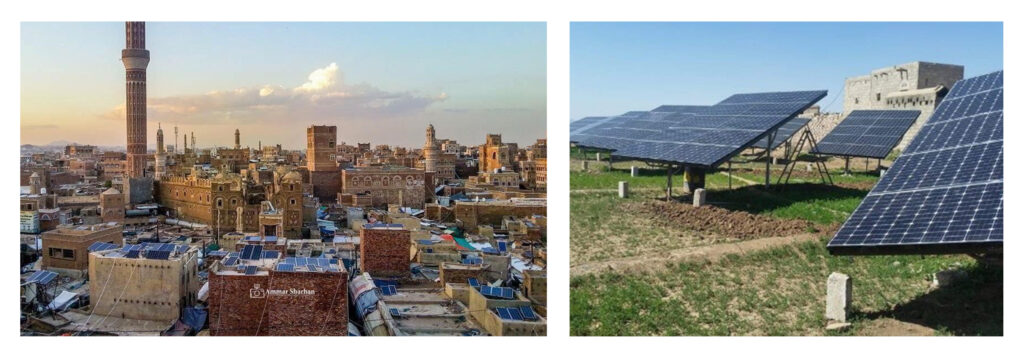
Figure 1: Newly installed solar panels on Sana’a houses and SPIS at a farm in Sana’a Basin
Before the outbreak of the 2011 protests, a 2009-2020 plan to develop and modernize the electric power infrastructure in Yemen was developed by the Public Electricity Corporation (PEC). The plan proposed to increase electricity production to three times 2009 levels, an increase equivalent to 3 gigawatts (GW), to serve factories and new areas and homes that did not have access to the public network.[23] Due to the unrest, all power plants stopped working completely in 2016.[24] Figure 2 illustrates the planned and actually produced electricity over the plan’s time period. The decline in the production of electrical energy began appearing clearly in 2011.[25] Since the war started, the national network has largely ceased to function, replaced locally by small private networks, primarily powered by household-level solar power, though few have enough storage or capacity to operate equipment with high energy demands, such as.[26]
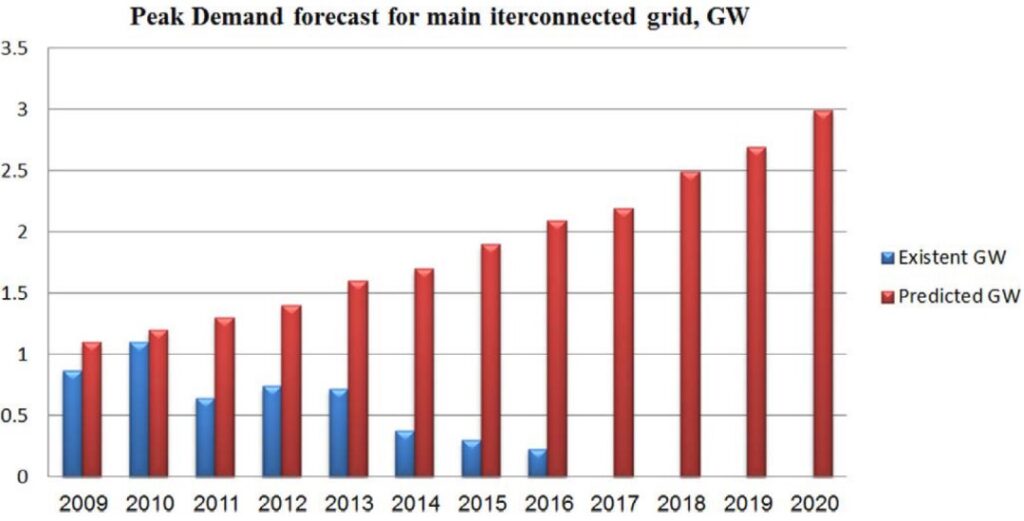
Figure 2: Strategic Electricity Plan up to Year 2020[27]
2.4 New SPIS technologies in Yemen
Solar energy is an eco-friendly, renewable source but many commentators say that it is a double-edged sword in Yemen.[28] While solar pumps can improve access to water and save energy, they might affect aquifers. During the current fuel crisis, many urban public water authorities have begun to use solar-powered groundwater pumping systems to supply domestic water. Using solar pump systems for drinking water supplies has a significant positive impact on water accessibility and, consequently, health and hygiene. However, the use of solar energy for irrigation might lead to over-abstraction of groundwater and add pressure to already stressed water resources. There are around 100,000 pumps in use in Yemen for irrigation purposes.[29] Replacing diesel and electric powered pumps with SPIS without clear rules and restrictions, particularly on qat farms, could lead to the expansion of the cultivation area and, hence, to an unforeseen increase in groundwater abstraction.
SPIS, once installed, has a relatively low cost per unit of power generated. Having said that, farmers try to maximize their use of groundwater in order to recover the high capital costs of the SPIS – either by expanding their irrigated area or by selling water to other farmers. This could lead to a race to the bottom unless regulations are put in place and enforced. Another concern is the drop in costs of solar panel technology. It dropped from around $76/W in 1977 to $0.30/W in 2015. This continuous drop, coupled with increasing diesel prices, has made this type of technology more attractive not only for farmers but also for many decision-makers, funders and technicians. SPIS is an energy-and-water solution that has as much potential to aggravate the water-scarcity problem as to improve the energy-access problem.[30] However, financial incentives to save energy cannot be applied here to avoid wasteful water use. The risks posed by unregulated solar-powered pumping must be identified and addressed, so as to clearly define policies and regulations to mitigate these risks and incentivize sustainable water use.
3. Research methodology
3.1 Study area
Yemen has 14 water basins. This study focuses on Sana’a Basin (figure 3). Sana’a Basin has 22 sub-basins and spans nine administrative districts, including the Yemeni capital, Sana’a city. The basin has an area of 3,240 km2 and hosts a current population of 4 million.[31] This study’s main unit of analysis is farmers from different hydrogeological areas: Bani Husheish, Bani Mater and Hamdan. The climate of Sana’a Basin is arid and mild throughout the year, with average temperature ranges between 12 and 25° C.[32] Mean annual duration of sunshine per day is 9 hours.[33] Annual rainfall typically ranges between 110 and 350 mm, with an average of 240 mm.[34] However, some years have much higher rainfall, above 350 mm.[35] Rainy days range from 8 to 25 days per year and mainly occur in the two rainy seasons: mid-March to beginning of April and mid-July to end of August.[36]
Sana’a Basin relies to a large extent on groundwater for both irrigation and domestic water uses.[37] As a result of rapid population growth in Sana’a city (over 5 percent[38]), uncontrolled immigration and the expansion of agriculture activities, water demand has increased tremendously in the last three decades and new wells continue to be drilled.[39] Today there are more than 13,000 wells in Sana’a Basin. The point of intersection, or balance, between groundwater recharge and abstraction was in 1985, after which groundwater abstraction has kept constantly increasing beyond the basin’s recharge (figure 4).[40] The groundwater aquifers of Sana’a Basin are now suffering over-exploitation. Annual abstraction exceeds 220 million m3, five to six times higher than the volume added through natural recharge, and the water-level decline is about 4-8 m per year.[41] About 90 percent of Sana’a Basin groundwater is used for agricultural activities, with qat and grapes as the most dominant crops.[42]
3.2 Research methods and data collection
This study conducted field surveys in December 2020 and January 2021 among a stratified sample of 88 farmers in Sana’a Basin, mainly from Bani Husheish, Bani Mater and Hamdan.[43] The study also undertook key informant interviews (KIIs) with water, irrigation and energy experts to ensure coherence between data at the farmer level and professional- and administrative-level information. This approach facilitated a deeper understanding, from different perspectives, of the future of SPIS, its uses and proper management, in Yemen. After a quality check on the collected data, where needed, participants were contacted by phone to verify unclear or incomplete points.
Sana’a Basin was selected as the study area because it faces water scarcity and has deeper groundwater than other basins; information on the use of SPIS in such a deep basin can be roughly extrapolated to apply to other areas, with the assumption that SPIS use in shallower basins would be easier. However, to cross check, a small sample of data (10 farmers) was collected from Hadramawt, where groundwater depth is <100 m.
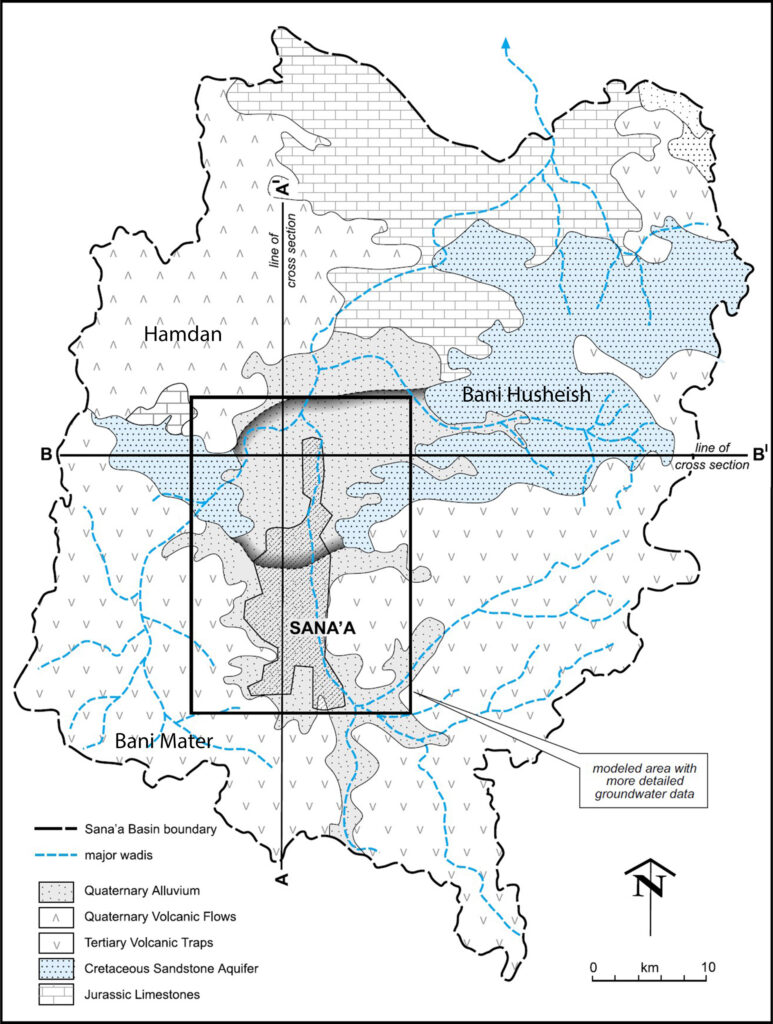
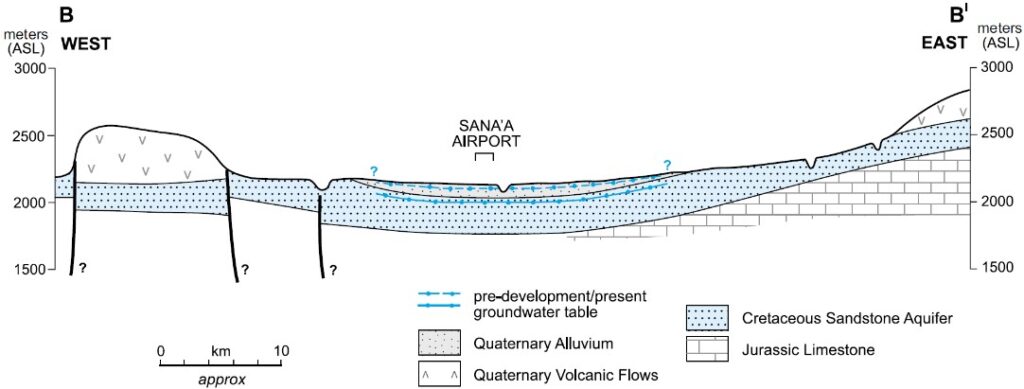
Figure 3: Hydrogeological map and cross-section (B-B) of the Sana’a Basin[44]
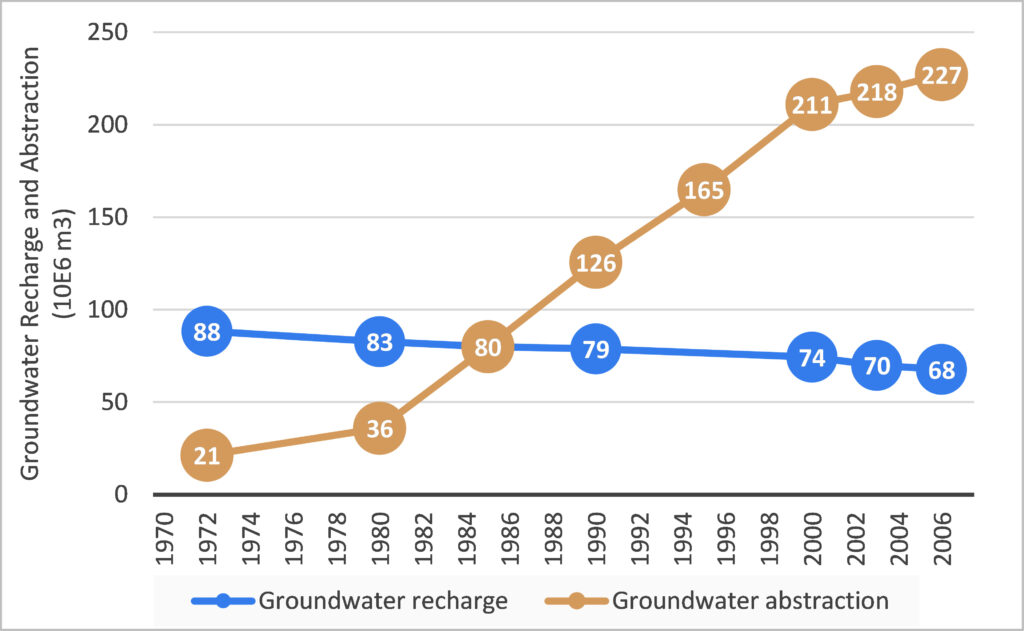
Figure 4: Groundwater recharge and abstraction in Sana’a Basin[45]
4. Results and discussions
The use of SPIS in Sana’a Basin is dramatically increasing. Today more than 30 percent of farmers in this area are using SPIS (figure 5). This was not the case prior to the current war, when almost all groundwater users in Yemen depended on diesel generators and the electricity grid to pump for irrigation.[46] The early reasons for this shift (2015-2017) were war-related – mainly the lack of electricity in the public network and the scarcity and high price of diesel. Now, and with the growing experience of farmers, the main reason for the shift to solar energy is the lower operation and maintenance costs of SPIS (figure 6) and the fact that it is more reliable than diesel pumps. All users of SPIS report being happy because they can get the quantity of water they used to have and pay almost nothing, bar the capital cost.
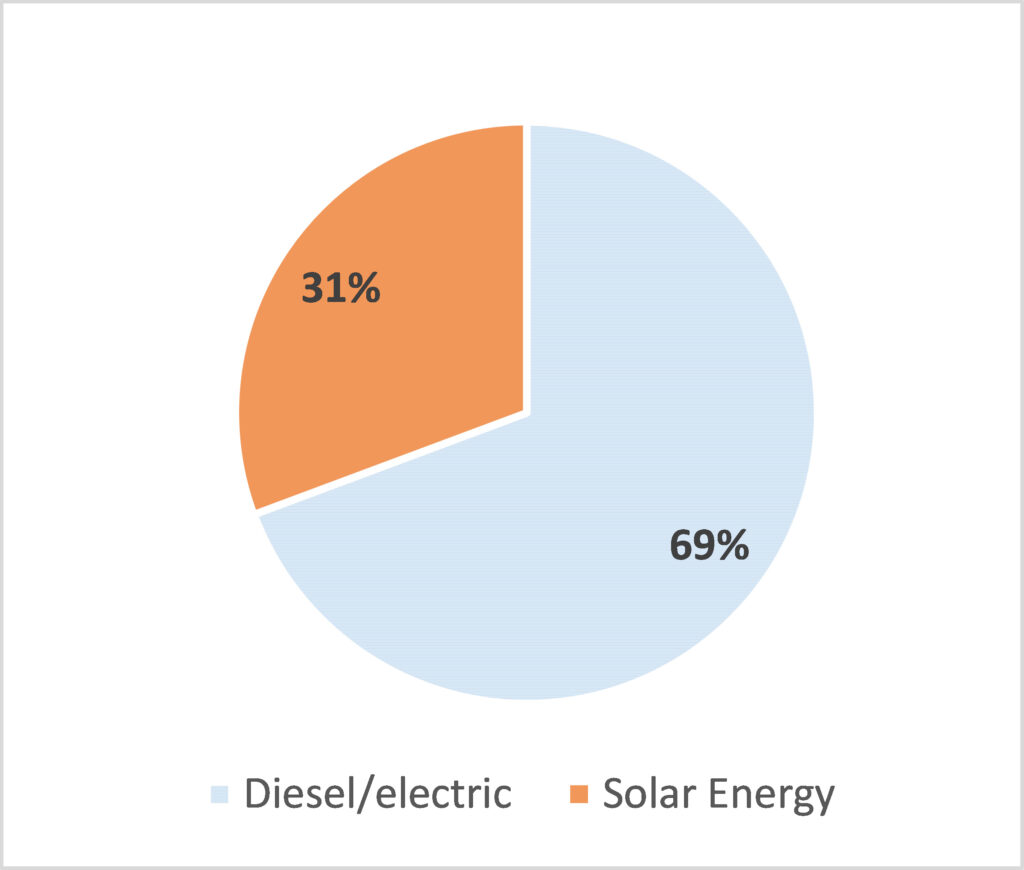 |
 |
|
Figure 5: Sources of energy for irrigation practices (Jan 2021) |
Figure 6: Reasons led to SPIS uses (Jan 2021) |
The number of installed SPIS systems is increasing with time. It jumped from 0 percent in 2012 to 12 percent in 2017 to 31 percent by the end of 2020 (figure 7). Likewise, the pumping capacity of SPIS, represented by pumping depth, has witnessed a remarkable development in Sana’a Basin. SPIS use in 2014-2015 was limited to shallow groundwater (<15 m) before increasing to 360 m in 2017 and reaching 500 m in 2020 (figure 8). During the current war and the closure of most Yemeni airports and seaports (particularly in the north), the average uptake of SPIS in Sana’a is increasing by 4.4 percent per year. If this trajectory were to continue, all old pumping systems in Sana’a Basin would be replaced or supported by SPIS within 15 years. If Yemen’s sociopolitical and security situation stabilizes, the conversion to SPIS is predicted to be far quicker; given the experience gained by farmers and the growing solar energy market in Yemen, the country would be expected to witness a complete shift to SPIS within only 7 years.
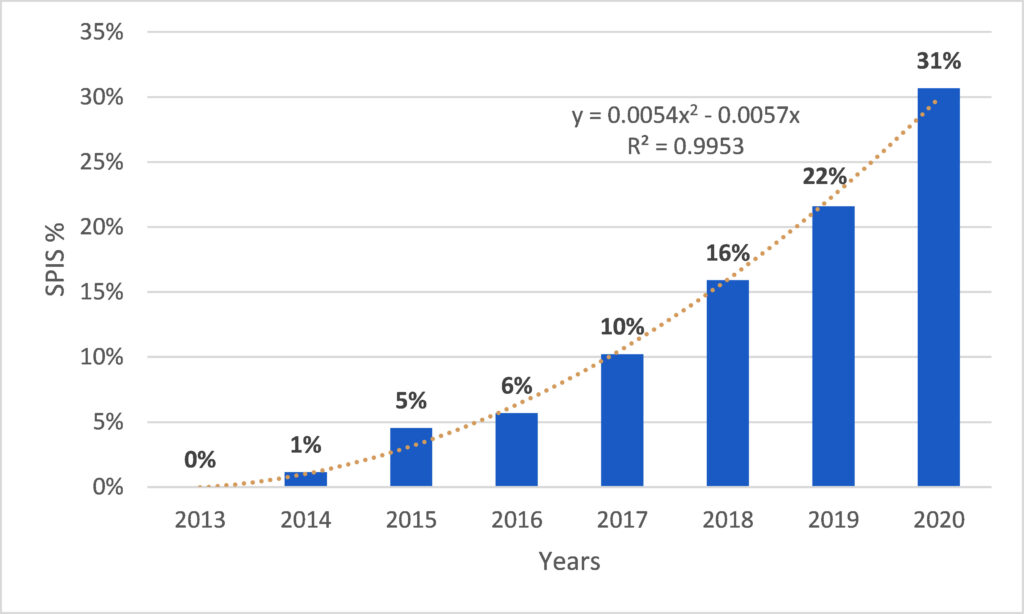
Figure 7: Accumulative installed SPIS
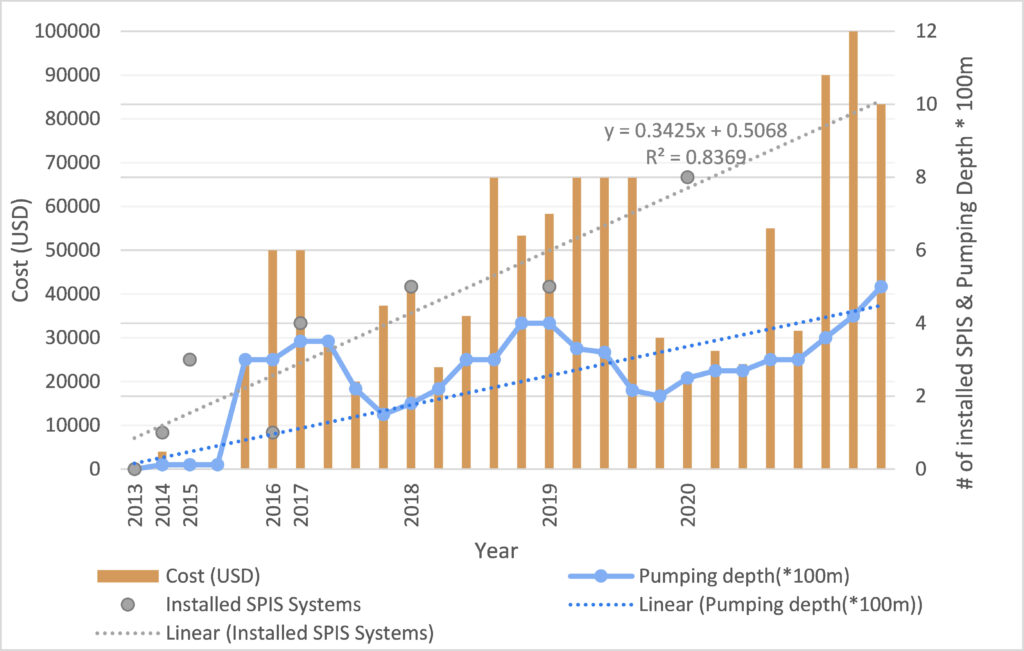
Figure 8: Installed SPIS, Related Costs & Pumping Depth (2014-2020)
The SPIS installation cost ranges between US$4,000 for shallow groundwater wells and up to US$100,000 for deep groundwater wells (figure 6). The increased depth directly correlates to increased cost; with time, SPIS installation depth and, consequently, costs are increasing. However, the exact relationship between cost and depth is not constant. The quality of the SPIS system (brand and country of origin) and the size (number of solar panels) are also important factors in pricing. Water depth, sun exposure and the system’s efficiency and capacity are the main factors determining pumping capacity. Some farmers said that SPIS secures them water quantities equal to what they used to obtain using other pumps, while other farmers said they obtain even more using SPIS. “Nine hours with the SPIS is equivalent to using a diesel pump from 6 in the early morning until midnight,” a farmer said.

Figure 9: why not SPIS until now?
All owners of wells are willing to use SPIS and the main obstacle for most farmers (69 percent) is the capital cost of SPIS. One farmer regretted the opportunity he lost in 2008, when he was offered a free SPIS and refused it. “I was unaware of its advantages,” he said. In a number of areas in Sana’a Basin, farmers share ownership of the wells and pumps. In these areas, local agreements require everyone to share ownership of wells located within their property. When some have no money to pay their share for drilling the well and installing the pump (mostly diesel and electric pumps), other farmers pay in advance for them. The farmers who jointly own wells report facing difficulties replacing their old pumps with solar ones because they use time-based distribution allocations, which is not fully applicable by SPIS. Whereas diesel pumping produces a constant amount of water, variation in solar radiation means that solar pumping can extract different amounts of water. The possible inequity in water quantities obtained in the time allocated means that some joint owners have doubts about introducing solar pumping. Among all farmers surveyed in Sana’a, 28 percent are unwilling to install SPIS due to these partnership concerns and a small minority (3 percent) were not interested in a new SPIS system because they rarely use their traditional pumping systems (figure 9).
Sandstone and quaternary alluvium areas in Sana’a Basin, such as Bani Husheish, have, for the most part, seen a more drastic increase in SPIS systems as compared with quaternary and tertiary volcanic areas, like Bani Mater. The flat land in Sana’a, such as Bani Husheish, is more fertile than mountainous areas and hosts more rich farmers with qat farms. This significantly helped the spread of solar energy pumps. In Bani Husheish, more than 400 solar pumps had been installed by 2017 (figure 10), approximately 20 percent of the total number of wells in that area.
Among the interviewees there were two farmers using SPIS in both Sana’a and Hudaydah. Although the pumps in Hudaydah cost them less and need shallower pumping depths (30-60 m) than in Sana’a, they are happier with their pumps in Sana’a because the crop there is qat, which is more profitable. The benefits of SPIS in Sana’a outweigh the initial costs because the crops grown there are lucrative. This finding was also supported by the comparative experience of Hadramawt farmers, many of whom have lower financial capacity and have been forced to sell their old pumping systems to cover part of their SPIS costs. In Sana’a, the majority of farmers keep their old diesel/electrical systems and use them as a standby or supplemental system.
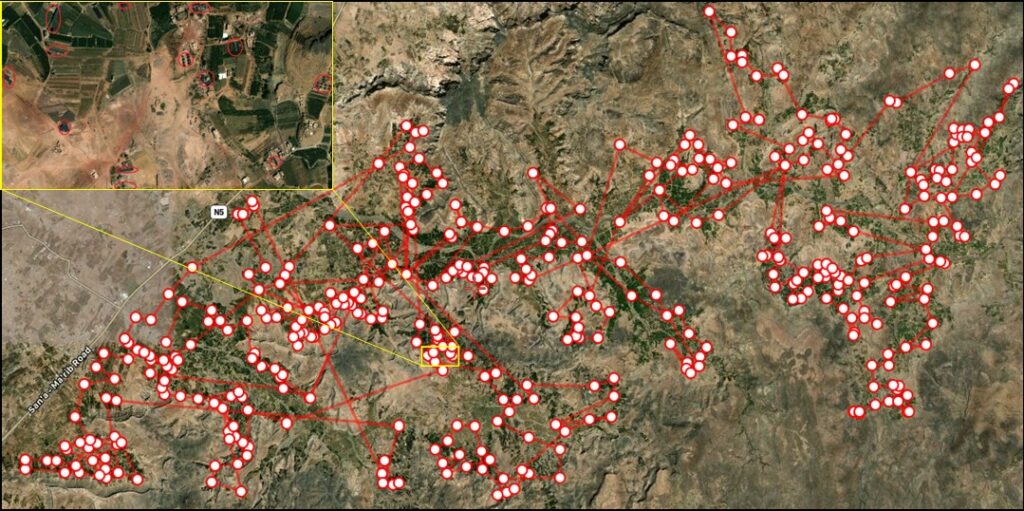
Figure 10: Digitizing map of 438 SPIS in Bani Husheish (2017)
As is the case in Sana’a, farmers in Hadramawt prefer SPIS to other pumping systems. The pumping depth in Hadramawt (30-60 m) is more suitable for solar pumps and the use of SPIS has started to spread widely. It is worth mentioning that a number of farmers in Hadramawt have expressed concern about the impact of solar energy technologies on the groundwater levels in the absence of clear regulations and policies. Nevertheless, the Hadrami farmers describe SPIS as a good system with fewer technical problems than electric and diesel systems. The SPIS cost in Hadramawt ranges from US$10,000 to 17,000. The capital cost is the main obstacle preventing most Hadramawt farmers from owning SPIS technology.
The SPIS users in Sana’a and Hadramawt interviewed for this paper received no training on installation, operation or maintenance except a little information about installation from the marketing companies. These users confirmed that they do not have any specific programs or policies to regulate the use of SPIS.
During the current war, farmers have not experienced the kind of drop in groundwater levels experienced before the war.[47] “In the last three years I installed not a single pipe,” one said, indicating that his supply had been sufficient. Long periods of diesel crisis led to a drop in the operating hours of diesel pumps, meaning less water was pumped and, consequently, groundwater resources were under less pressure. Moreover, rainfall in 2019 and 2020 was far higher than usual. “If the rainfall continues as in the last two years we will rarely use groundwater,” a farmer in Sana’a said. SPIS use – while helping to mitigate the challenges posed by the fuel crisis – is not a reason for increased groundwater stability reported by some farmers, primarily because it is still in its early stages. Only 31 percent of surveyed farmers in Sana’a are using these systems. Most of the SPIS adopters are large landholders – those who could have afforded diesel to operate pumps, even in the current fuel crisis.
The diesel crisis is still relevant in early 2021 and many farmers buy diesel on the black market. This study found that the average price of diesel per liter is YR500 and YR325 in Sana’a and Hadramawt respectively.[48] These prices, current as of January 2021, are about five and three times diesel’s pre-crisis price. Since 2011, diesel prices have, at times, reached 15 times their pre-crisis levels. However, with more SPIS systems or increased diesel availability, it is expected that farmers will gradually start to abstract an even greater volume of groundwater than they did in the pre-war period.
Over the course of the conflict, there has been a decline in crop production across the country.[49] The number of qat farms is increasing at the expense of other crops, whose area is diminishing. Wells are being drilled without any involvement of official authorities. “In our area there were more than 200 farmers of crops other than qat; today, there are around 20,” one farmer in Bani Husheish noted. The expansion of qat farms – which, because of the crop’s high water needs, are usually irrigated – increases concerns about the future abstraction of groundwater, especially when Yemen’s situation stabilizes and the availability of SPIS and diesel increases.
There is considerable interest from development actors to support the use of SPIS in Yemen. A number of farmers have already received some support from local organizations (Azal and Al-Wataniah were mentioned by respondents) and international ones (e.g. FAO, IOM, UNDP, CARE, OXFAM and Mercy Corps). Some of these supporting organizations control the maximum depth SPIS can be used for, but this is not always the case. The farmers now know how to get technical support and upgrade these systems. Farmers with large landholdings are able to both buy SPIS systems and access further funds from organizations. Owners of smaller farms face greater barriers to installing SPIS, and some farmers reported that they sold assets like cars and gold in order to buy SPIS. The majority of respondents couldn’t yet afford this technology, although they want it. Solar energy pumps are being promoted and supported by many local and international organizations, on the basis that they save fuel and electricity, protect the environment, reduce CO2 emissions and have health benefits and other social returns. However, there are concerns, mainly from water experts, about the potential impact of SPIS. So far there has been no study in Yemen on what can be done to regulate the use of solar energy, especially in the field of irrigation.
Solar pumps are seen as a potentially powerful solution to government shortcomings in providing electricity grid connections for agriculture. The potential impact of solar pumps on excessive groundwater extraction is generally not seen as a major concern by most policymakers. Farmers are seeing solar pumps as both a pumping and an energy solution. From an economic perspective, any resource that has become easily accessible will inevitably be overexploited, unless access to and use of this resource is restricted through government regulation and policies.
Expert Perspectives
Yemeni energy experts have posited that solar-powered water-pumping might help to conserve groundwater and stabilize water levels, given the time restrictions on pumping (8-10 hours a day) and the limited capacity of these systems. However, no study has systematically assessed these trade-offs. Rather, some studies suggest that the introduction of solar pumps could pose additional risks of over-extraction. The risk that SPIS proliferation is likely to worsen over-exploitation of aquifers is particularly clear given the cautionary tale of historic diesel subsidies, which led to the over-exploitation and dramatic decline of groundwater resources over decades.[50] Increased water wastage has been reported following extensive solar pumping in parts of India and China, for example.[51]
The present study shows that most farmers kept their old pumps to use them at night or when needed. All SPIS owners in Sana’a Basin kept their old pumps (mostly diesel) as standby systems. Others (6 percent) have more than one well and operate both diesel and solar pumping systems. The current users of SPIS rely mainly on solar systems and use diesel pumps only when the SPIS supply is insufficient, mainly during night time in the summer season or on cloudy days. In fact and as mentioned earlier, some farmers have reported abstracting more with SPIS. There is growing evidence that the low operational cost and available energy of SPIS contribute to excessive extraction of groundwater, decreasing water tables and negatively affecting water quality.[52] Yemeni energy experts are supportive of the use of solar energy in all sectors, with their main concern being the quality of imported solar energy equipment, rather than any long-term environmental impact.
Yemeni water and irrigation experts agree and support the use of SPIS in Yemen but in a way that prevents further depletion of scarce groundwater. The use of SPIS minimizes consumption of imported fuel and electricity, alleviates the pressure on the economy (since the Yemeni economy relies, to a large extent, on fuel) and, more importantly, provides a cheaper and ecologically friendlier way of pumping water. This is particularly important in rural areas, where agriculture is the main livelihood option. However, the potential impact of SPIS on groundwater abstraction in the absence of clear policies and regulations cannot be ignored. Therefore, more detailed comprehensive studies on the potential negative impact of SPIS, compared to the traditional fuel-powered systems, are needed.
Although SPIS has limitations of capital cost and pumping time limits, there is still a risk of over-exploitation of groundwater resources associated with the widespread use of SPIS technology, hybrid solar systems and related subsidies. In Morocco, for instance, targeted subsidies for solar pumping have been put on hold due to the government’s growing concern over the depletion of groundwater resources.[53] Another concern is that farmers might irrigate more during the daytime, which lowers irrigation efficiency and water productivity. Most farmers in Yemen are still practicing old methods of flood irrigation and few have modern irrigation systems. These concerns need to be addressed systematically at the community and policy levels, and comprehensive policies and regulations must be prepared. Water experts don’t believe that farmers should be supported with subsidies to cover the capital costs of SPIS, instead advocating for support to be given in the form of technical assistance and capacity building alongside information on sustainable water management.
From the point of view of the farmers surveyed, the main constraints on SPIS expansion include the initial high investment cost, primarily, but also the variable quality of panels, converters and pumps due to the absence of standardization, certification and import controls, worsened in some cases by dishonest dealers.
Water-Energy-Food Nexus & SPIS
Food security is a challenge in Yemen. But a focus on that challenge should not come at the expense of the country’s endangered water security. SPIS can increase food production by harnessing reliable and sustainable energy to provide timely irrigation. However, these benefits may be at risk as many technical feasibility studies on SPIS fail to appropriately evaluate available water resources and water use and the arising trade-offs within the water-energy-food nexus (Figure 11). Efforts to achieve food security in Yemen should always be linked with water security. Given the large numbers of rural Yemenis and their dependence on agriculture, ensuring the use of the most appropriate and water-saving irrigation technology is very important. However, activating traditional rainwater harvesting systems and developing rain-fed agriculture are of equal importance, as many areas have insufficient groundwater to enable more than very minimal, supplementary irrigation; other areas have none. The most suitable areas for irrigation using SPIS are those with annual rainfall ranging from 300-400 mm, such as Hajjah and Ibb. In all cases, both the benefit of SPIS and the sustainability of groundwater in the area under study should be considered.

Figure 11. The water energy food nexus with SPIS[54]
5. Conclusions
Although the findings of this study suggest caution in the use of solar power for irrigation, it should be emphasized that its promotion both for the supply of domestic water and of household electricity is an entirely positive development that should be encouraged. Solar power is, in this way, providing basic services to the population, particularly for thousands of rural households throughout the country who would otherwise not have access to these essential facilities.
With respect to sustainable management of Yemen’s scarce water resources, the main finding of this study is that SPIS requires better regulation and management, alongside other water extraction mechanisms, primarily in agriculture, but also for domestic and other uses. The field data collected for this study demonstrates that the use of SPIS has dramatically increased in the last decade in Yemen. The data also shows that the use of solar energy for irrigation in solar-rich and groundwater-scarce Yemen is likely to adversely affect groundwater resources, in the absence of effectively implemented regulations. In other words, SPIS is yet another mechanism that, unless well managed, could contribute to worsening Yemen’s overall water scarcity. The crucial factor determining SPIS attractiveness for farmers is that the marginal cost of solar-powered pumping is almost negligible once they have made the initial investment.
What is also clear is that the cost of a solar irrigation system increases significantly with the depth of the water table. In the case of Sana’a Basin, where wells are deep, costs for installing SPIS reach up to US$100,000. This method of irrigation therefore increases the gap between poor and rich farmers. Even where water can be reached at lesser depths, the price of SPIS installation is still beyond the means of most smallholders. SPIS is more accessible for the wealthiest farmers – those who own other businesses and/or grow the highest value crops.
Overall, it is important to note that all forms of deep-well irrigation are beyond the means of the majority of smallholders. This has a number of implications. First and foremost, farmers can justify irrigating the highest value crops and, more likely than not, they will expand their qat areas at the expense of cultivating basic food crops, such as sorghum. Second, irrigation costs, alongside other economic pressures, are likely to concentrate land ownership even further, as smallholders are forced to sell their assets, thus gradually worsening social differentiation. Policies focused on reducing inequality need to take these factors into consideration when planning water management.
Sana’a Basin is not the only area where aquifers are now very deep; Sa’ada is another. The risk of unsustainable over-exploitation of aquifers and, ultimately, their exhaustion is high throughout the country. Exhaustion of aquifers means not only an end to agriculture but the end of an area being habitable, ultimately leading to forced migration.
Yemen’s formal legal frameworks on water are not fully implemented and, in any case, fail to address the newly introduced SPIS technologies. All legal frameworks and regulations concerning water and energy must be updated to take into consideration the specificities of solar energy technologies, including the use of SPIS. In the short term, it may be difficult to control technology uptake during the war. It is essential that all SPIS users, including the companies and organizations carrying out SPIS installations, increase their understanding of the fragility of water tables. This involves the development of a massive awareness program, which would help to optimize SPIS use and be a good start toward reducing the over-exploitation of aquifers. However, in the medium and long terms, authorities should regulate SPIS and ensure the safe and sustainable use of water resources in Yemen.
6. Policy recommendations
Given the current conflict, a number of the recommendations below will only be applicable once effective government has been restored throughout the country. Meanwhile, those which can be implemented should be done so as soon as practicable.
6.1 General recommendations
- National, governorate and local authorities should coordinate their water management policies in order to ensure priority access to water for domestic use, followed by livestock and other non-agricultural uses.
- The Ministry of Planning and International Cooperation and the MAIF should aim to maximize the benefits of rain-fed agriculture, through research on high value rain-fed crops as well as high-yielding and drought-resistant staple crops. Once sustainable methods have been identified, local MAIF offices should develop effective extension programmes to encourage their introduction.
- All water management authorities (NWRA, MAIF, local authorities) should ensure that irrigation from groundwater is only permitted where replenishment of the water source is guaranteed, whether from shallow or deep aquifers. At the local level, regulations must be enforced with determination.
- NWRA and other water management-concerned authorities are not sovereign bodies, and therefore strong coordination with and support from the official sovereign authorities are always needed, unless laws and policies will remain on paper, as many of their predecessors.
- MWE and NWRA to reconsider the possibility of establishing judicial authority for water, which began to be discussed at the beginning of the last decade.
- Central and local governments should jointly implement a national awareness campaign on water management issues, including the risks of depletion of resources, the local and national impact of over-extraction (including the implications of upstream over-extraction on downstream users) and the positive and negative potential impact of SPIS and other irrigation technologies.
- International funders should continue to finance and promote solar energy for domestic use, for the supply of both water and electricity to households, particularly in rural areas. Even more attention should be given to remote, dispersed and isolated households. These domestic water and energy-supply projects should be financed through public or community organizations, and accompanied by training in equipment maintenance, as well as effective certification of the quality of the technology.
- NWRA, MAIF and AREA (Agricultural Research and Extension Authority) should carry out studies in each water basin to assess the impact, opportunities and limitations of SPIS, producing an SPIS risk map for the entire country to define the areas of high risk. The coastal groundwater reserves, with lower depth, are likely to be more adversely affected by this technology than the highlands.
- International development partners should finance these studies, as well as support mechanisms for quality control and certification of imported solar and other technology. Local authorities should ensure that traders uphold the required standards.
- The national authority of Yemen Standardization, Metrology and Quality Control Organization should implement quality control, certification and standardization protocols for SPIS technology and Tax Authority in the Ministry of Finance to impose taxes on imported solar irrigation technology.
- An administrative SPIS unit should be established in the National Water Resources Authority.
- MAIF and NWRA should formulate specific regulations determining permissible pumping depths based on the actual groundwater level and renewable water availability in each basin; for instance, in Sana’a Basin, SPIS should be allowed up to a maximum depth of 200 m (as a safe depth for scarce and deep groundwater) and with maximum outputs of up to 250 m3/day. Controlling pumping depth facilitates control of actual water extraction, as this is determined by the number of solar panels installed, which indicates the capacity of the pump. The number of solar panels installed can be detected by satellite imagery as well as photographs from UAVs, a technology that is now easily accessible.
- MAIF and NWRA should also ensure the implementation of additional restrictions on the use of diesel and electric pumps, as they are the main driving forces of groundwater depletion.
- In order to conserve groundwater and increase irrigation efficiency and water productivity, SPIS should be combined with modern irrigation technologies.
- Ensure the necessary support for farmers in training, awareness programs and technical skills.
- To ensure successful and viable SPIS policies, promote the involvement of local communities – including women and youth – and coordination across all related sectors.
- Hany Sady et al. “Prevalence and associated factors of Schistosomiasis among children in Yemen: implications for an effective control programme,” PLOS Neglected Tropical Diseases, vol. 7, no. 8 (August 2013).
- Talha Burki, “Yemen’s neglected health and humanitarian crisis,” Lancet, vol. 387 (2016); “Yemen Humanitarian Crisis Analysis 2016,” Swedish International Development Cooperation Agency (SIDA), February 20, 2016, https://doi.org/10.1016/S0140-6736(16)00389-5
- Misiedjan D, Van Rijswick M, Kwoei ATA “A human right to water while the well runs dry: Analysing the legal and regulatory framework of Yemen water law” Journal of Water Law, vol. 24, (August 2014).
- There is a 10 page document by the General Department for Renewable Energy at the Ministry of Electricity and Energy. It is called “National Strategy for Renewable Energy and Energy Efficiency”, which listed renewable energy options, efficiency targets, etc. However, it does not rise to the level of what we call a strategy and has not been approved by the cabinet. https://www.climate-laws.org/geographies/yemen/policies/national-strategy-for-renewable-energy-and-energy-efficiency
- A. M. Al-Ashwal, “Market development of PV Solar Home System (SHS) and PV pumping in Yemen,” 18th International Conference on Sustainable Energy Technologies, Kuala Lumpur, Malaysia, 2019; Murad Almekhlafi, “Justification of the Advisability of Using Solar Energy for the Example of the Yemen Republic Technogenic and Ecological Safety,” Scientific and Technical Journal (2018); Adel Saleh Rawea and Shabana Urooj, “Strategies, current status, problems of energy and perspectives of Yemen’s renewable energy solutions,” Renewable and Sustainable Energy Reviews, vol. 82, part 1 (February 2018); A. Abdullah, “Sustainable Energy Futures, Energy Poverty in Yemen School of Engineering” (conference paper), University of Edinburgh, 2018.
- “Good Practices and Lessons Learned: Solar Interventions under ERRY Project in Yemen (Abyan, Hajjah, Hodeidah, and Lahj),” UNDP, February 27, 2019, https://reliefweb.int/report/yemen/good-practices-and-lessons-learned-solar-interventions-under-erry-project-yemen-abyan
- Helen Lackner, Yemen in Crisis: The Road to War (New York: Verso, 2019), 247.
- Most recent water statistic from FAO’s Aquastat “Country Statistics” tool, see: http://www.fao.org/nr/water/aquastat/data/query/index.html?lang=en.
- “Future Impact of Climate Change Visible Now in Yemen,” World Bank, November 24, 2014, https://www.worldbank.org/en/news/feature/2014/11/24/future-impact-of-climate-change-visible-now-in-yemen
- Helen Lackner and Abdulrahman Al-Eryani, “Yemen’s Environmental Crisis Is the Biggest Risk for Its Future,” The Century Foundation, December 14, 2020, https://tcf.org/content/report/yemens-environmental-crisis-biggest-risk-future/
- Alvar Closas and Francois Molle, “Groundwater Governance in the Middle East and North Africa,” IWMI Project Report No. 1, December 2016, https://publications.iwmi.org/pdf/H048385.pdf
- “Yemen – Assessing the impacts of climate change and variability on the water and agricultural sectors and the policy implications,” World Bank, April 22, 2010, https://documents.worldbank.org/en/publication/documents-reports/documentdetail/979121468153566240/yemen-assessing-the-impacts-of-climate-change-and-variability-on-the-water-and-agricultural-sectors-and-the-policy-implications; Taha Taher et al. “Local groundwater governance in Yemen: Building on traditions and enabling communities to craft new rules,” Hydrogeology Journal, vol. 20 (May 21, 2012).
- Wahib al-Qubatee et al. “Participatory Rural Appraisal to assess groundwater resources in Al Mujaylis, Tihama Coastal Plain, Yemen,” Water International, vol. 42, no. 7 (September 2017).
- Murad Almekhlafi, “Justification of the Advisability of Using Solar Energy for the Example of the Yemen Republic Technogenic and Ecological Safety,” Scientific and Technical Journal (2018).
- Adel Saleh Rawea and Shabana Urooj, “Strategies, current status, problems of energy and perspectives of Yemen’s renewable energy solutions,” Renewable and Sustainable Energy Reviews, vol. 82, part 1 (February 2018).
- A. Abdullah, “Sustainable energy futures, energy poverty in Yemen School of Engineering,” University of Edinburgh, 2018.
- More information in forthcoming work: Akram M. Almohamadi, “Priorities for the Recovery and Reform of the Electricity Sector in Yemen” DeepRoot Consulting,
- Musaed Aklan, Charlotte de Fraiture, Laszlo Hayde, “Which Water Sources Do People Revert to in Times of War? Evidence from the Sana’a Basin, Yemen,” International Journal of Environmental Research, vol. 13, no. 4 (May 2019).
- Clemens Breisinger et al. “Managing transition in Yemen: An assessment of the costs of conflict and development scenarios for the future,” International Food Policy Research Institute, 2012, https://www.ifpri.org/publication/managing-transition-yemen; Adel Al-Weshali et al. “Diesel subsidies and Yemen politics: Post-2011 crises and their impact on groundwater use and agriculture,” Water Altern, vol. 8, no. 2 (June 2015).
- Clemens Breisinger et al. “Managing transition in Yemen: An assessment of the costs of conflict and development scenarios for the future,” International Food Policy Research Institute, 2012, https://www.ifpri.org/publication/managing-transition-yemen
- Musaed Aklan, Charlotte de Fraiture, Laszlo Hayde, “Which Water Sources Do People Revert to in Times of War? Evidence from the Sana’a Basin, Yemen,” International Journal of Environmental Research, vol. 13, no. 4 (May 2019).
- Ibid.
- Adel Saleh Rawea and Shabana Urooj, “Strategies, current status, problems of energy and perspectives of Yemen’s renewable energy solutions,” Renewable and Sustainable Energy Reviews, vol. 82, part 1 (February 2018).
- Ibid.
- Ibid.
- Frank van Steenbergen and Musaed Aklan “Yemen: Water and energy in times of war,” Down to Earth, November 14, 2016, https://www.downtoearth.org.in/blog/water/yemen-water-and-energy-in-times-of-war-56298
- Adel Saleh Rawea and Shabana Urooj, “Strategies, current status, problems of energy and perspectives of Yemen’s renewable energy solutions,” Renewable and Sustainable Energy Reviews, vol. 82, part 1 (February 2018).
- Musaed Aklan, Charlotte de Fraiture, Laszlo Hayde, “Which Water Sources Do People Revert to in Times of War? Evidence from the Sana’a Basin, Yemen,” International Journal of Environmental Research, vol. 13, no. 4 (May 2019).
- “Water situation in Yemen” (presentation), NWRA, 2013.
- Alvar Closas and Edwin Rap, “Solar-based groundwater pumping for irrigation: Sustainability, policies, and limitations,” Energy Policy, vol. 104 (May 2017).
- Musaed Aklan, Charlotte de Fraiture, Laszlo Hayde, “Which Water Sources Do People Revert to in Times of War? Evidence from the Sana’a Basin,” Yemen International Journal of Environmental Research, vol. 13, no. 4 (May 2019).
- Ahmed Al-Ameri et al. “Characteristics of Stable Isotopes of Oxygen-18 and Deuterium of Groundwater in the Sana’a Basin Aquifer Systems, Yemen,” Arabian Journal for Science and Engineering, vol. 39 (April 23, 2014); Ahmed Mohamed Alderwish, “Integrated water management for small catchments in arid mountainous region – Yemen,” Energy Environment and Economics Research Compendium, vol. 19 (January 2013).
- Ahmed Mohamed Alderwish, “Integrated water management for small catchments in arid mountainous region – Yemen,” Energy Environment and Economics Research Compendium, vol. 19 (January 2013).
- Ahmed Al-Ameri et al. “Characteristics of Stable Isotopes of Oxygen-18 and Deuterium of Groundwater in the Sana’a Basin Aquifer Systems, Yemen,” Arabian Journal for Science and Engineering, vol. 39 (April 23, 2014); Jan Willem Foppen, M. Naaman and Jack Schijven, “Managing water under stress in Sana’a, Yemen,” Arabian Journal for Science and Engineering, vol. 30, no. 2 (December 2005); Taha Taher, “Groundwater abstraction management in Sana’a Basin, Yemen: A local community approach,” Hydrogeology Journal, vol. 24, no.6 (May 2016).
- Abdulhakim Al-Kholid et al. “Approach to quantification drawdown of groundwater wells: A case study from Sana’a City, Yemen,” Global Geology, vol. 13 (2010).
- Ahmed Mohamed Alderwish, “Integrated water management for small catchments in arid mountainous region – Yemen,” Energy Environment and Economics Research Compendium, vol. 19 (January 2013); Yahya Alwathaf and Bouabid El Mansouri, “Hydrodynamic modeling for groundwater assessment in Sana’a Basin, Yemen,” Hydrogeology Journal, vol. 20, no. 7 (November 2012).
- Abdulhakim Al-Kholid et al. “Approach to quantification drawdown of groundwater wells: A case study from Sana’a City, Yemen,” Global Geology, vol. 13 (2010).
- The annual growth rate in Sana’a Basin was 5.5 percent in urban areas (where 86 percent of the total population live) and 3.2 percent in rural areas (14 percent of population) as of the 2004 population census, according to the Yemeni Central Statistical Organization (MOPIC CSO).
- Ahmed Al-Ameri et al. “Characteristics of Stable Isotopes of Oxygen-18 and Deuterium of Groundwater in the Sana’a Basin Aquifer Systems, Yemen,” Arabian Journal for Science and Engineering, vol. 39 (April 23, 2014); Yahya Alwathaf and Bouabid El Mansouri, “Hydrodynamic modeling for groundwater assessment in Sana’a Basin, Yemen,” Hydrogeology Journal, vol. 20, no. 7 (November 2012).
- Yahya Alwathaf and Bouabid El Mansouri, “Hydrodynamic modeling for groundwater assessment in Sana’a Basin, Yemen,” Hydrogeology Journal, vol. 20, no. 7 (November 2012).
- Jan Willem Foppen, M. Naaman and Jack Schijven, “Managing water under stress in Sana’a, Yemen,” Arabian Journal for Science and Engineering, vol. 30, no. 2 (December 2005); Taha Taher, “Groundwater abstraction management in Sana’a Basin, Yemen: A local community approach,” Hydrogeology Journal, vol. 24, no.6 (May 2016).
- Taha Taher, “Groundwater abstraction management in Sana’a Basin, Yemen: A local community approach,” Hydrogeology Journal, vol. 24, no.6 (May 2016).
- The authors gratefully acknowledge the essential contribution made by the field data collectors and all surveyed farmers. Without their work and help, this report would not be possible.
- Taha Taher, “Groundwater abstraction management in Sana’a Basin, Yemen: A local community approach,” Hydrogeology Journal, vol. 24, no.6 (May 2016).
- Musaed Aklan, Charlotte de Fraiture, Laszlo Hayde, “Which Water Sources Do People Revert to in Times of War? Evidence from the Sana’a Basin, Yemen,” International Journal of Environmental Research, vol. 13, no. 4 (May 2019).
- Ibid.
- Farmers are not able to measure the water level exactly; however, when the quantity of pumped water starts to drop and more foam is produced in the pumping process, farmers know that the water level has likely decreased and more pipes must be installed.
- It is worth noting that fuel prices vary enormously according to the amount of fuel allowed to enter the country by the Saudi-led coalition and the manipulations of stocks carried out by merchants who also, often, play a role on the black market. This black market activity is, today, being practiced in plain sight.
- Adel Al-Weshali et al. “Diesel subsidies and Yemen politics: Post-2011 crises and their impact on groundwater use and agriculture,” Water Altern, vol. 8, no. 2 (June 2015).
- Musaed Aklan, Charlotte de Fraiture, Laszlo Hayde, “Which Water Sources Do People Revert to in Times of War? Evidence from the Sana’a Basin,” Yemen International Journal of Environmental Research, vol. 13, no. 4 (May 2019).
- “Renewable energy in the water, energy and food nexus,” International Renewable Energy Agency (IRENA), January 2015.
- Tushaar Shah and Avinash Kishore, “Solar-powered pump irrigation and India’s groundwater economy: A preliminary discussion of opportunities and threats,” IWMI-TATA Water Policy Program, 2012, http://www.iwmi.cgiar.org/iwmi-tata/PDFs/2012_Highlight-26.pdf; “Renewable energy in the water, energy and food nexus,” IRENA, January 2015.
- Alvar Closas and Edwin Rap, “Solar-based groundwater pumping for irrigation: Sustainability, policies, and limitations,” Energy Policy, vol. 104 (May 2017).
- Alvar Closas and Edwin Rap, “Solar-based groundwater pumping for irrigation: Sustainability, policies, and limitations,” Energy Policy, vol. 104 (May 2017).

 اقرأ المحتوى باللغة العربية
اقرأ المحتوى باللغة العربية

